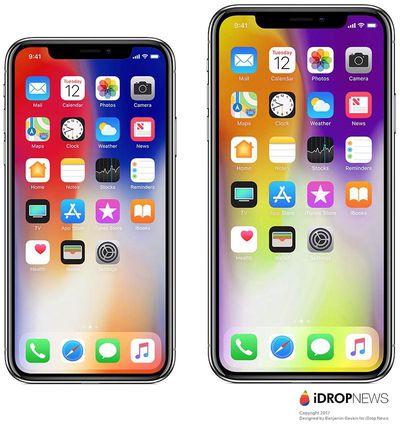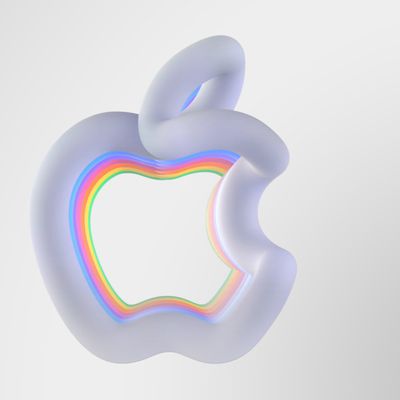LG Display Could Supply OLED Displays for This Year's 'iPhone X Plus'
LG Display saw its shares surge to a one-month high on Wednesday following a report that the company will begin supplying OLED panels to Apple's new range of iPhones this year (via Financial Times).
LG's stock rallied on an Electronic Times report that the South Korean firm would make over 15 million OLED panels for Apple's 2018 range of iPhones. LG is already a supplier of LCD panels, currently used in the iPhone 8 and iPhone 8 Plus, but Samsung dominates supply of OLED displays for Apple's flagship iPhone X. Indeed, last week LG Display revealed in a regulatory filing that it didn't supply any of the OLED panels currently used in the iPhone X.

However, that could change this year, since Apple is expected to launch
two new 5.8-inch and 6.5-inch iPhone models with OLED displays in 2018. According to today's report, LG Display will supply Apple with the 6.5-inch OLED panels, while Samsung will supply the 5.8-inch or 6-inch OLED panels.
Reports have been trickling out since July 2017 that Apple has invested billions of dollars in LG's OLED production capability for smartphones, but the fruits of its investment were thought to be some ways off. LG was initially reported to have secured 45,000 panels per month for future iPhones from 2019, while as recently as September it was suggested that Apple would have to wait until at least next year before it could move beyond Samsung for significant supplies of OLED panels. However, Wednesday's report suggests LG could secure its position as the number two supplier of OLED screens for Apple's iPhones as early as the second half of 2018. LG is said to be planning to mass-produce the panels for Apple at its Gen 6 flexible OLED production line located in Paju, South Korea.
LG came in for scrutiny recently after it emerged that the firm supplied Google with the Pixel 2 XL's OLED displays, some of which were reportedly prone to screen burn-in or image retention issues. It remains unclear whether the problems stemmed from LG or other factors were involved, although the smaller Pixel 2 and original Pixel phones – both with Samsung-supplied OLED displays – have experienced far fewer issues. It's also worth noting that Apple says OLED displays can show "slight visual changes" after extended long-term use and minor screen burn-in is considered normal.
The new iPhone X and iPhone X Plus will likely launch around the usual timeframe of September to October, potentially alongside a new 6.1-inch mid-range model with an LCD display.
Popular Stories
Apple's next-generation iPhone 17 Pro and iPhone 17 Pro Max are just over two months away, and there are plenty of rumors about the devices.
Below, we recap key changes rumored for the iPhone 17 Pro models.
Latest Rumors
These rumors surfaced in June and July:Apple logo repositioned: Apple's logo may have a lower position on the back of the iPhone 17 Pro models, compared to previous...
Apple should unveil the iPhone 17 series in September, and there might be one bigger difference between the Pro and Pro Max models this year.
As always, the Pro Max model will be larger than the Pro model:iPhone 17 Pro: 6.3-inch display
iPhone 17 Pro Max: 6.9-inch displayGiven the Pro Max is physically larger than the Pro, it has more internal space, allowing for a larger battery and...
In 2020, Apple added a digital car key feature to its Wallet app, allowing users to lock, unlock, and start a compatible vehicle with an iPhone or Apple Watch. The feature is currently offered by select automakers, including Audi, BMW, Hyundai, Kia, Genesis, Mercedes-Benz, Volvo, and a handful of others, and it is set to expand further.
Apple has a web page with a list of vehicle models that ...
The calendar has turned to July, meaning that 2025 is now more than half over. And while the summer months are often quiet for Apple, the company still has more than a dozen products coming later this year, according to rumors.
Below, we have outlined at least 15 new Apple products that are expected to launch later this year, along with key rumored features for each.
iPhone 17 Series
iPho...
Apple is continuing to refine and update iOS 26, and beta three features smaller changes than we saw in beta 2, plus further tweaks to the Liquid Glass design. Apple is gearing up for the next phase of beta testing, and the company has promised that a public beta is set to come out in July.
Transparency
In some apps like Apple Music, Podcasts, and the App Store, Apple has toned down the...
Since the iPhone X in 2017, all of Apple's highest-end iPhone models have featured either stainless steel or titanium frames, but it has now been rumored that this design decision will be coming to an end with the iPhone 17 Pro models later this year.
In a post on Chinese social media platform Weibo today, the account Instant Digital said that the iPhone 17 Pro models will have an aluminum...
New renders today provide the best look yet relocated Apple logo and redesigned MagSafe magnet array of the iPhone 17 Pro and iPhone 17 Pro Max.
Image via Majin Bu.
Several of the design changes coming to the iPhone 17 Pro model have been rumored for some time, such as the elongated camera bump that spans the full width of the device, with the LiDAR Scanner and flash moving to the right side.
...
Amazon is soon to be back with its annual summertime Prime Day event, lasting for four days from July 8-11, the longest Prime Day yet. As it does every year, Prime Day offers shoppers a huge selection of deals across Amazon's storefront, and there are already many deals you can get on sale ahead of the event.
Note: MacRumors is an affiliate partner with Amazon. When you click a link and make a ...
Apple's position as the dominant force in the global true wireless stereo (TWS) earbud market is expected to continue through 2025, according to Counterpoint Research.
The forecast outlines a 3% year-over-year increase in global TWS unit shipments for 2025, signaling a transition from rapid growth to a more mature phase for the category. While Apple is set to remain the leading brand by...






















